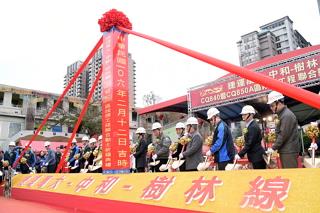Mayor Presides over Ground-breaking Ceremony for MRT Wanda Line
On February 12, Mayor Ko Wen-je presided over the ground-breaking ceremony for sections CQ840 and CQ850A of MRT Wanda Line.
During his speech, the mayor noted that the start of works at these two sites symbolizes that construction of Taipei’s portion of the new MRT line is underway. He emphasized that this is a statement of the city regarding the implementation of its revitalization project for Zhongzheng and Wanhua districts as well.
He noted that the overhaul of the North Gate is slated for completion by June of 2017. At that time, visitors will notice the entire landscape around the area has changed and North Gate will serve as an iconic landmark of Taipei just like how tourists think of the Arc de Triomphe when they think of Paris.
With the North Gate serving as the “core,” the renovation project extends northward with the revamp of the Jiancheng Circle, Dalong Public Housing, and Dalong Market. The overhaul of Minglun Public Housing will kick-off next month as well.
The mayor added that almost every mayor would visit the Lanzhou Public Housing as election year nears, but the question of renovation has been left unanswered for decades. He noted that the overhaul of the complex will start in 2018 at the latest. Even the development project for Shezidao is also entering the environmental evaluation stage.
Heading south, the challenging reconstruction of the Huannan Market has begun on November 6, 2016. Ko also requested to see progress regarding the overhaul of both the Fruits and Vegetables Wholesale Market and Taipei Fish Market by the end of the year. Several city agencies are relocating to the newly completed Wanhua Twin Towers. The city government also drafted a plan spanning 2.5 years for the overhaul of Nanmen Market.
According to Ko, the most important factor of the revitalization project for Zhongzheng and Wanhua districts is the MRT Wanda Line. Despite all the renovations, the most important issue is transportation – especially for old neighborhoods. He repeated the difficulties cited by the Department of Rapid Transit Systems (DORTS) on building a new line through the older section of the cities – narrow roads, crowded pipeline networks, and historical sites, to name a few. Constructions will have to proceed carefully, striking a balance between the schedule and preservation of historical sites.
Another challenge will be crossing the Xindian River to connect with the section in New Taipei City. Furthermore, arranging work in a way to minimize impact upon schools along the way throughout constructions also requires effort, given the number of such institutions located near future stations.
Ko recalled that after two years at city hall, his administration is able to save nearly NT$42 billion for Taipei. While NT$30 billion were used to pay off debts, the city treasury still maintains NT$12 billion in cash, allowing the city government to undertake construction projects on its own, without having to rely on BOTs. He is confident that DORTS will maintain quality throughout the construction, with over three decades of experience in this field.


![Taiwan.gov.tw [ open a new window]](/images/egov.png)
